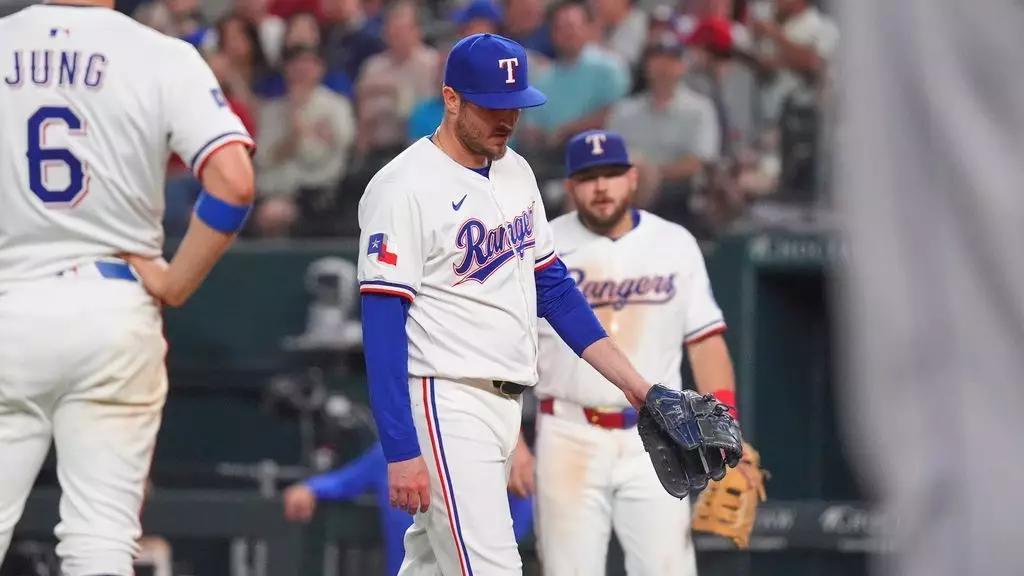In the world of sports, injuries often emerge as both a dramatic twist and a cruel reality. Recently, Texas Rangers closer Luke Jackson was thrust into this dilemma during a nail-biting game against the Colorado Rockies. Jackson, who made a brief appearance in the ninth inning of a tense 2-1 victory, faced an unforgiving 111-mph comeback liner that bolted off his pitching hand. This incident highlights not only the volatility of the sport but underscores the precarious nature of a player’s health, particularly in high-pressure situations.
Manager Bruce Bochy’s immediate response to the incident involved confirming that Jackson’s X-rays were negative. Nevertheless, the swelling in his right hand raised red flags, leaving the team in uncertainty. While the Rangers emerged victorious, the lingering fear of Jackson’s potential stint on the injured list looms large, casting a shadow over what could be a significant loss for the team.
The Psychological Toll of Injury
Tyler Mahle, who had delivered a commendable 6⅓ innings to secure the win, expressed sympathy and concern for his teammate’s situation. His poignant remark about Jackson’s unfortunate turn of events, “It just sucks,” embodies the anguish teammates often feel when witnessing a fellow athlete’s misfortune. Injuries like Jackson’s serve as a sobering reminder of the sport’s brutal reality—players often grapple not solely with physical pain but also with the psychological ramifications posed by injuries. The suddenness of such events can weigh heavily on a locker room, instigating a ripple effect that can be felt by the entire team, as fears of further injuries and the prospect of navigating replacements loom large.
Absences Stack Up: The Case of Corey Seager
Compounding the Rangers’ worries is the ongoing absence of star shortstop Corey Seager, sidelined for a significant portion of recent games due to hamstring soreness. Seager’s missed games raise critical questions about the stability of the lineup and the ability of the team to maintain competitive momentum. When he’s healthy, Seager is a formidable player, as evidenced by his impressive two-home-run performance just prior to this stretch of injuries. However, with Bochy’s acknowledgment that Seager is still a “day-to-day” case, the uncertainty about his return adds to the stress of managing a team with limited resources against rigorous competition.
It’s not inconceivable that encouraging players to maintain their physical and mental health is as vital as strategizing for the next game. With a wavering lineup and struggling health, the Rangers find themselves in a precarious position as the season progresses, raising concerns about depth and resilience.
From Crisis to Opportunity
In the face of adversity, however, opportunities for growth emerge. With Jackson’s injury and Seager’s absence, other players will need to rise to the occasion. This situation will prove crucial for teammates like Jacob Webb, who stepped up immediately following Jackson’s exit, showcasing that the depth of a roster can make—or break—success. When players face challenges, it fosters an environment where others step outside their comfort zone and redefine their roles, something that can catalyze unforeseen progress for the team as a whole.
This season’s path is laden with potential obstacles. Nevertheless, how the Rangers maneuver through this period of uncertainty can significantly define their character as a team. The potential to use these injuries as a catalyst for honing their resilience could ultimately be a game-changer, allowing the Texas Rangers to adapt, grow, and thrive amidst adversity, setting a tone that extends far beyond the diamond.
While the immediate focus lies on managing injuries and strategizing for upcoming games, the long-term implications of this testing time present both pitfalls and pathways to evolution. How the Rangers choose to react now could resonate for seasons to come, spotlighting the essential nature of adaptability in professional sports.

